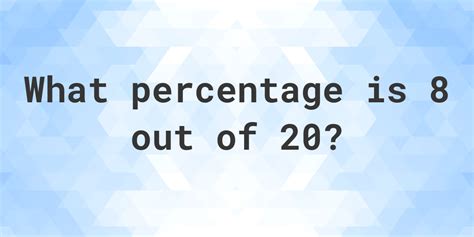What Is 8/20 As A Percentage
Kalali
Apr 01, 2025 · 4 min read

Table of Contents
What is 8/20 as a Percentage? A Comprehensive Guide
Converting fractions to percentages is a fundamental skill in mathematics with broad applications in various fields, from finance and statistics to everyday life. Understanding this process allows for easier comparisons and a clearer understanding of proportional relationships. This comprehensive guide will delve into the process of converting the fraction 8/20 into a percentage, explaining the methodology and exploring related concepts.
Understanding Fractions and Percentages
Before jumping into the conversion, let's clarify the core concepts:
-
Fractions: A fraction represents a part of a whole. It's expressed as a ratio of two numbers, the numerator (top number) and the denominator (bottom number). In our case, 8/20 means 8 parts out of a total of 20 parts.
-
Percentages: A percentage represents a fraction of 100. It's denoted by the symbol "%" and indicates a proportion relative to 100. For example, 50% means 50 out of 100, or one-half.
Converting 8/20 to a Percentage: Step-by-Step
The conversion of a fraction to a percentage involves two primary steps:
Step 1: Convert the Fraction to a Decimal
To convert a fraction to a percentage, we first need to express it as a decimal. This is done by dividing the numerator by the denominator:
8 ÷ 20 = 0.4
Step 2: Convert the Decimal to a Percentage
To convert a decimal to a percentage, we multiply the decimal by 100 and add the "%" symbol:
0.4 x 100 = 40%
Therefore, 8/20 is equal to 40%.
Simplifying Fractions Before Conversion
Often, simplifying the fraction before converting to a decimal can make the calculation easier. In this case, both 8 and 20 are divisible by 4:
8 ÷ 4 = 2 20 ÷ 4 = 5
This simplifies the fraction to 2/5. Now, let's convert 2/5 to a percentage:
2 ÷ 5 = 0.4
0.4 x 100 = 40%
As you can see, we arrive at the same result, demonstrating that simplifying the fraction beforehand doesn't alter the final percentage. This simplification technique is particularly helpful when dealing with larger numbers.
Practical Applications of Percentage Conversions
The ability to convert fractions to percentages is valuable in various real-world scenarios:
1. Finance and Budgeting
- Calculating interest rates: Understanding percentages is crucial for comprehending interest rates on loans, savings accounts, and investments.
- Analyzing financial statements: Financial reports often use percentages to represent key metrics like profit margins, revenue growth, and expense ratios.
- Budgeting and allocation: Percentages help in allocating resources effectively within a budget.
2. Statistics and Data Analysis
- Representing proportions: Percentages provide a clear and concise way to represent proportions within data sets. For instance, expressing survey results as percentages simplifies the interpretation of the findings.
- Calculating probabilities: Probabilities are often expressed as percentages, making it easier to understand the likelihood of an event occurring.
- Creating charts and graphs: Percentages are widely used in creating visual representations of data, such as pie charts and bar graphs.
3. Everyday Life
- Calculating discounts: Understanding percentages is essential when calculating discounts in stores or online.
- Determining tips: Calculating the appropriate tip in a restaurant usually involves working with percentages.
- Understanding tax rates: Tax rates are expressed as percentages, which directly impact the final price of goods and services.
Advanced Concepts Related to Percentage Conversions
While converting 8/20 to a percentage is relatively straightforward, understanding related concepts can enhance your mathematical skills:
1. Percentage Increase and Decrease
Calculating percentage increases and decreases involves determining the change in a value relative to the original value. For instance, if a price increases from $100 to $120, the percentage increase is:
[(120 - 100) / 100] x 100 = 20%
Similarly, a decrease can be calculated.
2. Percentage Points vs. Percentage Change
It's important to distinguish between percentage points and percentage change. A change of 5 percentage points means a direct addition or subtraction of 5 percentage units (e.g., from 10% to 15%). A 5% percentage change, however, refers to a relative change based on the original value.
3. Working with Percentages in Equations
Percentages can be incorporated into various mathematical equations. For example, to find x% of a number (y), you would calculate:
(x/100) * y
Conversely, to find what percentage x is of y, the calculation is:
(x/y) * 100
Conclusion: Mastering Percentage Conversions
Converting fractions like 8/20 to percentages is a fundamental skill with wide-ranging practical applications. By understanding the steps involved and exploring related concepts, you can confidently tackle percentage calculations in various contexts. This guide provides a solid foundation for building your mathematical proficiency and applying this knowledge effectively in your personal and professional life. Remember, practice is key to mastering this skill. Try converting different fractions to percentages to solidify your understanding. The more you practice, the faster and more accurate you'll become. From financial planning to data interpretation, your ability to work with percentages will empower you to make informed decisions and analyze information more efficiently.
Latest Posts
Latest Posts
-
27 16 As A Mixed Number
Apr 02, 2025
-
What Is 5 20 As A Percent
Apr 02, 2025
-
What Is 10 Percent Of 16
Apr 02, 2025
-
What Type Of Organic Compound Is Dna
Apr 02, 2025
-
How Much Is 50 Degrees Celsius In Fahrenheit
Apr 02, 2025
Related Post
Thank you for visiting our website which covers about What Is 8/20 As A Percentage . We hope the information provided has been useful to you. Feel free to contact us if you have any questions or need further assistance. See you next time and don't miss to bookmark.
